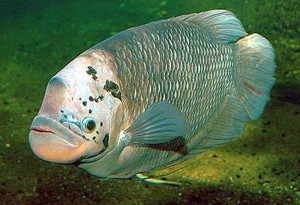Giant Gourami (Osphronemus goramy) are native to Southeast Asia and are found throughout Borneo, Java, Sumatra, Thailand, Indo-china and the Malay Peninsula. A recently described species called the Giant Red Tail Gourami (Osphronemus laticlavius) is slightly smaller and can be distinguished from Osphronemus goramy by its red fins. Although this species is considered rare to tropical fish keeping enthusiasts, it’s care is identical to Osphronemus goramy.
Giant Gourami (Osphronemus goramy) are found in stagnant, slow moving waters of swamps, lakes, and large rivers in fresh and occasionally brackish water conditions. Like other Anabantid, they have a well developed labyrinth organ that allows them to breathe moist atmospheric air and survive out of water, or in oxygen deficient conditions for extended periods. In their natural habitat they can grow to over 28″ long, but in an aquarium environment they seldom exceed 18″ in length.
Partly because of their size, Giant Gourami are an important food source in many parts of their range. They are commonly salted and dried in India and are popular in Malaysian, Indonesian, and even Sundanese cuisine.
Although they grow much larger than most gouramis, Giant Gourami are kept by many tropical fish keeping enthusiasts as juveniles when they are 2″ to 3″ long.
At this stage, they have a pronounced “beak” and have a pale to golden yellow body color, with silvery, pale blue vertical stripes running along the body.
The anal fins are large and rounded, and they have the distinctive elongated pelvic fins typical of gourami. The body is very narrow in width, and the dorsal and anal fins in males end in a pronounced point. Females have thicker lips than males.
These fish grow rapidly when provided with sufficient space and plenty of food, and within four or five years they can grow as long as 18″ to 20″ in length. As they mature, between 3 to 4 years of age, Giant Gourami will lose their juvenile coloring and turn a dark gray to almost black color. They will begin to develop a rounded face and a large “nuchal hump” on the head, just above their eyes. During spawning, the body colors of the fish turn almost black.
Giant Gourami are a relatively peaceful, long lived, extremely hardy, intelligent fish that make great “pets” for their owners. They develop real personalities and change their body color according to their moods. They recognize their owners and will visually respond to them with something akin to affection.
Giant Gourami are best housed in a 180 gallon or larger aquarium with a gravel or coarse sand substrate, plenty of hiding places in the form of large rocks or large pieces of driftwood, and because they are a “messy” fish, a powerful filtration system. These fish are extremely efficient herbivores, therefore floating plants
are much more preferable than having planted aquatic vegetation in the tank.
Giant Gourami are known to eat smaller fish, but they are usually peaceful with other large fish provided enough space if provided in the aquarium. As juveniles they can be housed with Angelfish, Bala Sharks, Bettas, Clown Loaches, Danios, Rainbowfish, Neons and most catfish.
As adults they may become aggressive, but this is usually due to being kept in an aquarium that is too small. In a large aquarium with plenty of space, these fish will usually get along well with the above species as well as knifefish, large catfish, and loricariids as long as they are introduced at the same time. Avoid adding new specimens to an established tank regardless of their size.
Giant Gourami are relatively easy to breed, but a huge tank is required to breed fully grown adults. Fortunately Giant Gourami are sexually mature at around 6 months, so it’s much more realistic to breed younger fish in lieu of adults.
Set up a large breeding tank with lots of floating plants and weeds or twigs so the male can build a large bubble nest using the vegetation. Spawning will occur close to the nest and the male will catch the eggs as they are fertilized an include them into the nest. After spawning is completed, the female should be removed from the breeding tank. The male tends to the nest until the eggs hatch, usually within 24 to 36 hours. The fry become free swimming 3 to 5 days later and the male will continue to guard the fry for several weeks. Most breeders elect to remove the male from the breeding tank once the fry are free swimming. They can be fed newly hatched baby brine shrimp or powered flake food almost from the first day.
Although Osphronemus goramy are omnivorous, they are voracious herbivores. In the wild they eat all types of vegetable matter and are even used for weed control in many areas, but they will also eat worms, amphibians, and sometimes even dead animals. In an aquarium environment, they are not fussy eaters but should be given an algae based flake food along with a varied diet of live, frozen or freeze dried bloodworms, tubifex
, brine shrimp, worms, and as adults; large pellets, legumes, fruits, and partially or fully cooked vegetables.
Giant Gourami are available to tropical fish keeping enthusiasts online and from specialty fish keeping shops as juveniles when they are 2″ to 3″ in length.
Minimum Tank Size: 180 gallons
Care Level: Easy
Temperament: Relatively Peaceful
Aquarium Hardiness: Very Hardy
Water Conditions: 68-86°F, 5-25°H, pH 6.5-8.0
Max Size: 28″
Color Form: Yellow, Gray, White
Diet: Omnivore/Primarily Herbivore
Compatibility: Large Community Tanks
Origin: Southeast Asia
Family: Osphronemidae
Lifespan: 20+ years
Aquarist Experience Level: Intermediate





